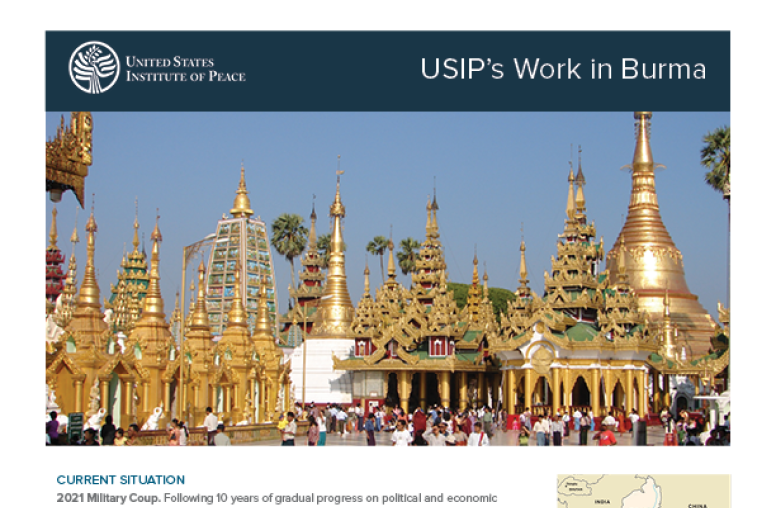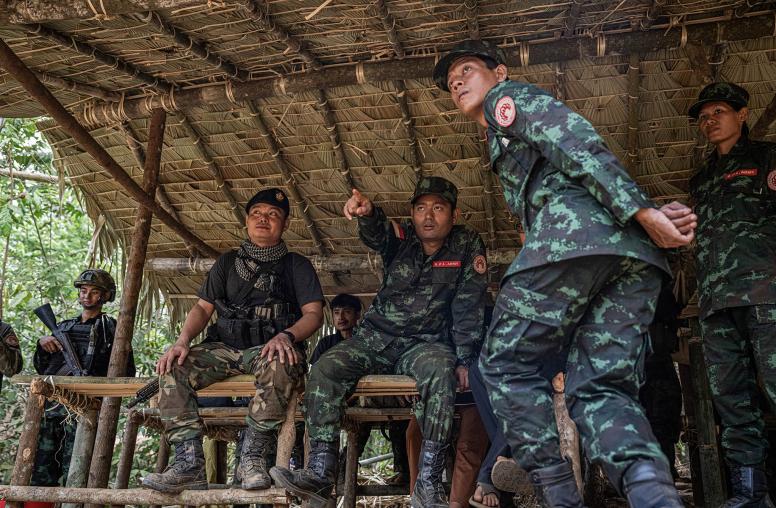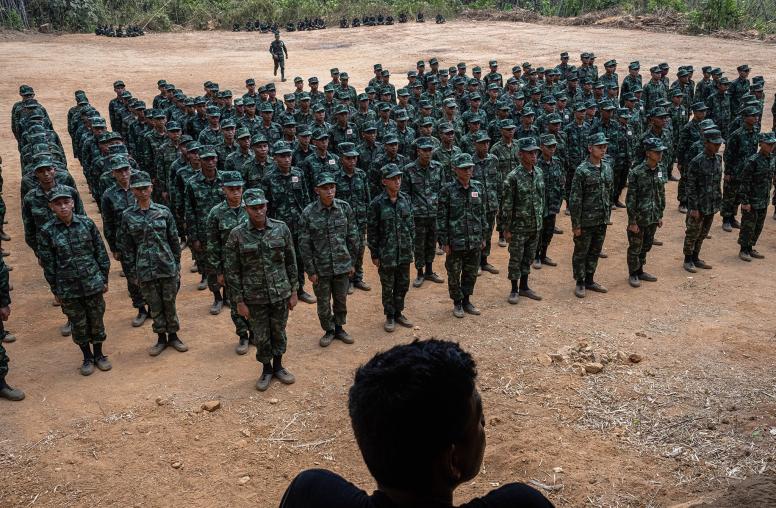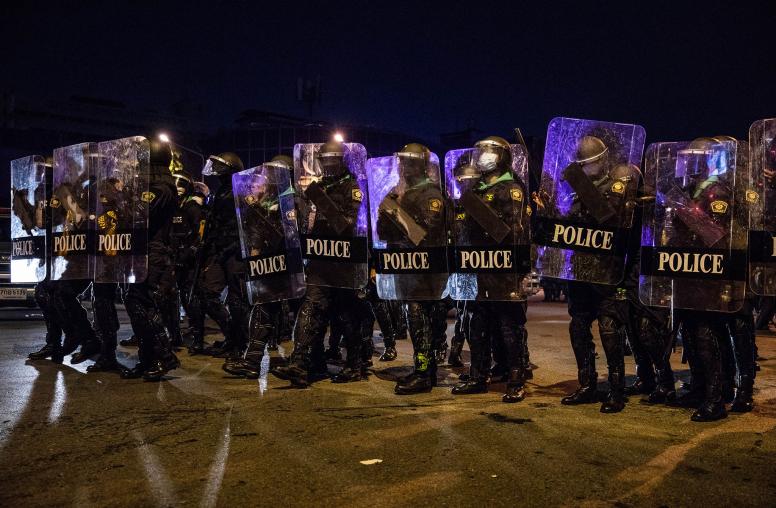Four Takeaways from the ASEAN Summit
From Myanmar’s crisis to China’s activities in the South China Sea to relations with Russia, the Southeast Asia bloc is at the center of many key global challenges.
Foreign ministers from the Association of Southeast Asian Nations (ASEAN) gathered last week in Jakarta, with a range of critical challenges to address. Chief among those issues was the crisis in member state Myanmar, which the bloc is divided on how to approach. China’s aggressive activities in the South China Sea were also a key topic at the summit, with Beijing and ASEAN pledging to reach an agreement on a long-stalled non-binding code of conduct.

ASEAN’s regional centrality means that the bloc is often thrust into broader geopolitical issues. At the ASEAN Regional Forum that took place alongside the foreign minister’s meeting, U.S. Secretary of State Antony Blinken and China’s top diplomat, Wang Yi, continued discussions on thawing U.S.-China ties. Russian Foreign Minister Sergei Lavrov also attended the regional forum. ASEAN countries have largely condemned the invasion of Ukraine but have focused on their own interests in engagement with Moscow.
USIP’s Jason Tower, Brian Harding and Alex Stephenson discuss how ASEAN countries are approaching Myanmar’s crisis and relations with Russia, where negotiations with China on the South China Sea stand, and the meeting between the top U.S. and Chinese diplomats at the regional forum.
1. Differences over Myanmar persist.
Tower: ASEAN’s deliberations on Myanmar’s crisis demonstrated that divisions over how to address the military’s ongoing war against the Myanmar people are impacting the Southeast Asian grouping much more than ASEAN can influence the situation in Myanmar. As the current ASEAN chair, Indonesia has followed a low-key approach, attempting to build cautious dialogue with the country’s diverse resistance actors, including the National Unity Government (NUG) and several ethnic armed organizations. While this should be seen as a welcome step, China’s growing assertiveness and high-level engagements with the military regime since December 2022 have prompted Myanmar’s neighbors to introduce their own platform for engagement with the military regime, undercutting Indonesia as chair.
Dubbed the “track 1.5” on Myanmar, this platform began convening in March of 2023 in Thailand, bringing together representatives of the military junta with all of Myanmar’s neighbors and most other mainland Southeast Asian countries. In the four months leading up to the ASEAN summit, this platform convened three times, mounting a campaign to overrule ASEAN’s decision made back in 2021 to suspend Myanmar’s participation in high-level ASEAN meetings at the ministerial level and above. While ASEAN ultimately rejected this move — keeping the junta out of the foreign minister’s meeting — China sent a strong signal of its preferences by inviting the junta’s minister of science and technology, Myo Thein Kyaw, to join a ministerial level China-ASEAN meeting on technology transfer overlapping with the ASEAN meeting on July 12.
Further overshadowing Indonesia’s efforts as chair, Thailand’s outgoing foreign minister, Don Parmudwinal, revealed at the ASEAN summit that he had made a secret visit to Myanmar, where Min Aung Hlaing granted him access to the country’s imprisoned State Counsellor Aung San Suu Kyi. This came as a considerable surprise given that repeated requests by the United Nations special envoy, subsequent ASEAN chairs, the United States, China and countless other governments and envoys had been rejected. Additionally, there was no effort made to coordinate the meeting with the ASEAN chair or with other stakeholders. The move was interpreted by the NUG as a form of “hostage diplomacy,” with the Myanmar army leveraging its close relationship with the outgoing government of Thailand to manipulate both international and domestic perceptions of Aung San Suu Kyi’s views about the situation in country. As NUG Foreign Minister Zin Mar Aung pointed out, the way in which the meeting took place amounted to “nothing more than … cornering her to answer questions in the interests of her captor.”
Many ASEAN states have voiced some level of agreement with the NUG in this regard. The joint communique from the foreign minister’s meeting indicated that “a number of ASEAN member states” viewed Thailand’s move as positive, implying that others do not share this view. Meanwhile, Singapore released its own statement demanding that the ASEAN chair be granted access to Aung San Suu Kyi, and pointing out that violence has only continued to escalate. China on the other hand seems not to share these concerns. On July 14, the Chinese Ministry of Foreign Affairs released a read out of Chinese foreign policy chief Wang Yi’s meeting with the Thai foreign minister on the sidelines of the ASEAN summit, commending Thailand for its “positive contributions to addressing the Myanmar issue.”
2. ASEAN countries have a tricky balancing act to play with Russia.
Harding: ASEAN’s centrality in regional security architecture, with this year’s ASEAN chair hosting a series of major meetings, meant that Indonesia found itself at the center of geopolitics for the week, hosting Blinken, Wang and Lavrov, among others. ASEAN countries, which find themselves divided on many major geopolitical issues, have a range of views on Russia’s invasion of Ukraine. While no parties welcomed the invasion of Ukraine, they have mostly sought to avoid the topic and instead have advocated for their practical interests such as the export of grain and related food prices.
Indonesia, in its own unilateral capacity, has been the most active ASEAN member on the issue, with President Joko Widodo casting Indonesia as a potential “bridge for peace.” Jokowi visited Kyiv and Moscow ahead of Indonesia’s hosting of the 2020 G20 Summit and Defense Minister (and presidential candidate) Prabowo Subianto unveiled his own peace plan at the Shangri-La Dialogue, demonstrating Indonesia’s interest in playing a leadership role on the issue. This interest aligns with Indonesia’s longstanding “independent and active” foreign policy that is rooted in nonalignment and places Indonesia with a front-row seat in global affairs. Indonesian Foreign Minister Retno Marsudi notably took the opportunity to convene a trilateral meeting with Wang and Lavrov, visibly putting Indonesia at the center of the table and perhaps idealistically trying to shape how these two powers engage each other and the world.
3. A code of conduct for South China Sea remains elusive.
Harding: ASEAN and China have been negotiating a non-binding code of conduct for the South China Sea since 2002 and negotiations have been in a deep freeze since 2020. Last week, on the sidelines of the ASEAN Regional Forum, ASEAN and China announced an agreement to accelerate negotiations with the creation of new “guidelines.” While the announcement puts a good face on the issue, which was important to ASEAN chair Indonesia to mark the 20th anniversary of China joining ASEAN’s Treaty of Amity and Cooperation, negotiations remain intractable.
At issue is China’s ongoing, unlawful harassment of activities being conducted by Southeast Asian claimants in disputed waters ranging from fishing to energy exploration, and the freedom to conduct military activities. While ASEAN and China have agreed to another “reading” of a single draft, there are deep divisions about the contents, starting with basic issues of international law.
Regional political dynamics also suggest that substantive progress is highly unlikely to accelerate. The most notable recent change in ASEAN-China relations relates to the foreign policy disposition of the Philippines since the inauguration of President Ferdinand Marcos, Jr. in July 2022. Whereas his predecessor, Rodrigo Duterte, discarded the Philippines’ victory in the Arbitral Tribunal under the U.N. Convention of the Law of the Sea at the Hague that declared China’s claims in the South China Sea unlawful in a gambit to warm relations with Beijing, Marcos has instead relentlessly shined light on China’s swarming of vessels within the Philippines’ Exclusive Economic Zone and aggressive confrontations by China’s Coast Guard. With the Philippines again at the vanguard of ASEAN’s pushback against China’s activities in the South China Sea, an ASEAN-China agreement seems as unlikely as ever.
4. The high-level thaw in U.S.-China relations continues.
Stephenson: On the sidelines of the summit, Blinken met with Wang for the second time in less than a month. At a glance, the talks didn’t yield any breakthroughs. But assessing the meeting in isolation doesn’t do it justice. Regular and direct communication between a range of high-level officials will be necessary if any improvement is to be made in U.S.-China relations. To this end, Washington and Beijing have been building steady momentum, a trend which Blinken and Wang continued in Jakarta.
Blinken’s visit to China in June set the stage for Treasury Secretary Janet Yellen and Special Presidential Envoy for Climate Change John Kerry to make similar trips only weeks later. Last week, Chinese Ambassador Xie Feng met with top American defense officials at the Pentagon, an important step towards the resumption of military talks, which have been frozen last August. This modest return to communication could help lower the risk of conflict at a volatile time in the relationship. Moreover, it will tee up a meeting between Biden and Xi later this year, which could expand opportunities for a greater “thaw” by providing the relationship with much needed direction.
Ultimately, the Blinken and Wang meeting was a small yet significant step forward on the long road to détente. But building peace often requires workable minimums, not impossible maximums. Even in the absence of a flashy breakthrough, Washington's and Beijing’s agreement to keep talking is a promising sign.



